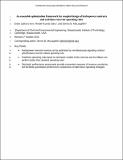An Ensemble Optimization Framework for Coupled Design of Hydropower Contracts and Real‐Time Reservoir Operating Rules
Author(s)
Sahu, Reetik Kumar; McLaughlin, Dennis
DownloadAccepted version (501.7Kb)
Open Access Policy
Open Access Policy
Creative Commons Attribution-Noncommercial-Share Alike
Terms of use
Metadata
Show full item recordAbstract
Revenues from hydropower generation often depend on the operator's ability to provide firm power in the presence of uncertain inflows. The primary options available for optimizing revenue are negotiation of a firm power contract before operations begin and adjustment of the reservoir release during operations. Contract and release strategy optimization are closely coupled and most appropriately analyzed with stochastic real-time control methods. Here we use an ensemble-based approach to stochastic optimization that provides a convenient way to construct nonparametric revenue probability distributions to explore the implications of uncertainty. The firm power contract is a simplified bilateral fixed price agreement that partially insulates operator and buyer from price fluctuations. The release control laws and firm energy target are jointly optimized to maximize the operator's expected revenue. Revenue probability distributions and related spill performance statistics indicate that predictive operating strategies such as stochastic dynamic programming and model predictive control can give significantly better performance than standard deterministic operating rules. The performance obtained from batch optimization with perfect inflow information establishes a convenient upper bound on potential revenue and provides a baseline for assessing the significance of differences between real-time operating strategies. Sensitivity analysis indicates that the benefits of predictive operational strategies are greatest for reservoirs with medium nondimensional residence times and less important for reservoirs with large residence times. Overall, probabilistic analysis of the coupled hydropower contract-operations problem provides a realistic way to assess revenue and risk for reservoirs that must provide firm power when inflows are uncertain. Keywords: optimal control; hydropower; stochastic optimization; contract optimization; real-time control
Date issued
2018-10Department
Massachusetts Institute of Technology. Department of Civil and Environmental EngineeringJournal
Water Resources Research
Publisher
American Geophysical Union (AGU)
Citation
Sahu, Reetik Kumar and Dennis B. McLaughlin. "An Ensemble Optimization Framework for Coupled Design of Hydropower Contracts and Real‐Time Reservoir Operating Rules." Water Resources Research, 54, 10 (October 2018): 8401-8419.
Version: Author's final manuscript
ISSN
0043-1397
1944-7973